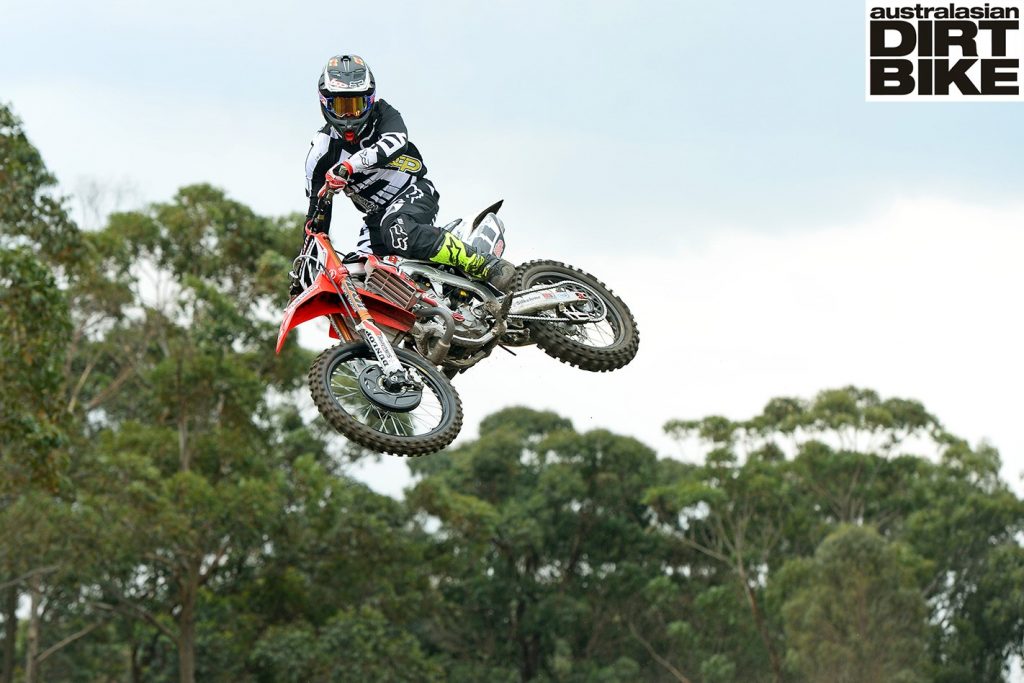Honda CR500 vs CRF450R
LAP TIMES
Hot lap CRF450R: 1:45.4
Hot lap CR500: 1:47.2
ENGINES
Without going into too much detail, the two engines are a lot closer in performance and speed than what a lot of people would think. Yes they produce a completely different type of power but out on the track the peak horsepower is very similar. Steve Haywood from Cisco’s Race Tuning in Croydon, Vic has built both of these engines and tuned them to run like clockwork.
My BCP 450R puts out a tad under 58hp while the CR500 puts out near on 60hp. The 450 has a different cam, worked head, bumped compression, Pro Circuit US-spec exhaust and a Vortex ignition while the 500 has had extensive cylinder work, a VHM head, a V-Force reed block, pipe and muffler.
Both engines are works of art in their own right but not exactly stock.
WARM UP
When I came back into the pits after warming up on both bikes, the first thing I thought was that my memories of the 500cc being ridiculously powerful were not so much the case anymore. And then it dawned on me that ever since I was 16, when my Dad had me racing a 250cc two-stroke and 500cc two-stroke, I have always compared the two. And yes there is a massive difference in brute horsepower between those two types of engines.
But, to be honest, I’d never ridden a high-horsepower 450 four-stroke back-to-back with a 500 two-stroke and it really changed the way I thought about the 500. Over the last six months I have tested some factory 450cc four-strokes for ADB that are punching out more horsepower than tricked-up 500cc strokers. The main difference being that, with a 500, you have a much narrower powerband to work with.
BRAKES
Far and away the biggest difference I felt right off the bat was the brakes, or lack of them, on the CR500. While the weight of the two bikes is very similar it actually feels like you are trying to stop a Mack truck when you pull on the CR500’s anchors.
There is a bunch of different reasons for this but first and foremost, the brakes just don’t work anywhere near as good as they do on the 450cc. Secondly, there is no engine braking on the stroker to assist you to stop and, thirdly, the way the 500 carries its weight seems to make the bike duck and dive and do all kinds of weird stuff under heavy braking.
And right there lies one of the biggest secrets in riding a big-bore two-stroke properly – that is to carry massive amounts of entry speed into corners and not brake too hard. Click up a gear and lug that big girl around!
LET’S ROCK
As expected, the CRF felt just like home. The CR took me a few laps to wrap my head around, not so much the engine but the handling characteristics and the way it carried its weight. They feel a lot heavier in the air but settle really well around the corners.
There was no way that I could take the same lines on this CR500 that I could take on the 450 and charging the face of the jumps became a roll of the dice. But once I got my lines sorted and stopped trying to ride it like I was Justin Barcia on a 125cc after a few Monster Energy drinks then everything started coming together.
The big 500 excelled in when we tested the starting ability of both bikes. We did 10 consecutive starts with a distance of 50m each time. The 500 won all ten tests by varying margins. The fact that you could pull third gear starts on the 500 easily meant that the meaty mid-range power would slightly pull on the 450cc.
We also tested the bikes in a rolling drag. Jay and myself would cruise along side by side and then pin it down the straight. The 500 would accelerate quickly each time, but as soon as we both snapped fourth gear, the 450 would start to reel the 500 back in. The 450 would take it by a couple of centimeters most times. The 500cc clearly had more peak horsepower but would not keep pulling at the same rate of the 450cc.



To receive the latest news, reviews and video highlights from the world of dirt bikes, sign up to our weekly newsletter here.











